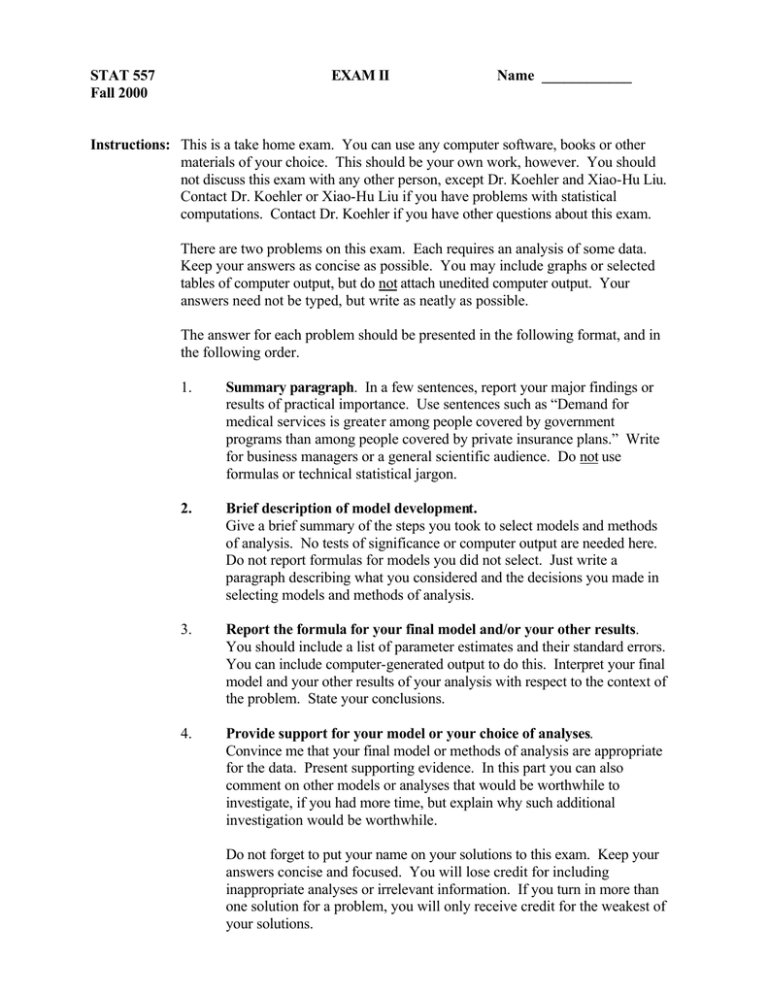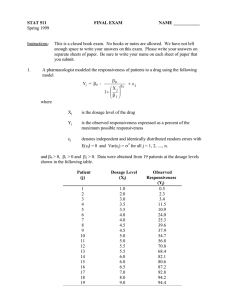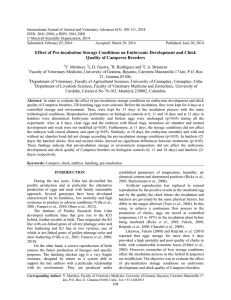STAT 557 EXAM II Name ____________
advertisement

STAT 557 Fall 2000 EXAM II Name ____________ Instructions: This is a take home exam. You can use any computer software, books or other materials of your choice. This should be your own work, however. You should not discuss this exam with any other person, except Dr. Koehler and Xiao-Hu Liu. Contact Dr. Koehler or Xiao-Hu Liu if you have problems with statistical computations. Contact Dr. Koehler if you have other questions about this exam. There are two problems on this exam. Each requires an analysis of some data. Keep your answers as concise as possible. You may include graphs or selected tables of computer output, but do not attach unedited computer output. Your answers need not be typed, but write as neatly as possible. The answer for each problem should be presented in the following format, and in the following order. 1. Summary paragraph. In a few sentences, report your major findings or results of practical importance. Use sentences such as “Demand for medical services is greater among people covered by government programs than among people covered by private insurance plans.” Write for business managers or a general scientific audience. Do not use formulas or technical statistical jargon. 2. Brief description of model development. Give a brief summary of the steps you took to select models and methods of analysis. No tests of significance or computer output are needed here. Do not report formulas for models you did not select. Just write a paragraph describing what you considered and the decisions you made in selecting models and methods of analysis. 3. Report the formula for your final model and/or your other results. You should include a list of parameter estimates and their standard errors. You can include computer-generated output to do this. Interpret your final model and your other results of your analysis with respect to the context of the problem. State your conclusions. 4. Provide support for your model or your choice of analyses. Convince me that your final model or methods of analysis are appropriate for the data. Present supporting evidence. In this part you can also comment on other models or analyses that would be worthwhile to investigate, if you had more time, but explain why such additional investigation would be worthwhile. Do not forget to put your name on your solutions to this exam. Keep your answers concise and focused. You will lose credit for including inappropriate analyses or irrelevant information. If you turn in more than one solution for a problem, you will only receive credit for the weakest of your solutions. 2 PROBLEM 1: The data for this problem were taken from a simple random sample of unmarried adults in Australia. The counts for a 2x6x3x2x2x2x2 contingency table are stored in the file exam2p1.dat that is available from the course web page. SAS and S-PLUS software for reading this file are stored in the files exam2p1.sas and exam2p1.ssc, respectively. There are eight numbers on each line of the file in the following order. Sex: 1 = female Age Group: 1 2 3 4 5 6 = = = = = = Health Insurance: 1 2 = covered by government insurance = covered by private insurance Illness: 1 = at least one illness in the last two weeks 2 = no illness in the last two weeks Chronic Conditions: 1 = at least one condition that requires long term medical care 2 = none Doctor Visits: 1 = consulted with a doctor in the last two weeks 2 = did not see a doctor in the last two weeks Other Health Care: 1 2 Count: 2 = male 20-29 years old 30-39 years old 40-49 years old 50-59 years old 60-69 years old at least 70 years old = at least one visit in the last two weeks with a non-doctor health professional (optician, physiotherapist, community nurse, chiropractor, social worker, pharmacist, etc…. = no such visit in the last two weeks The number of respondents This study was concerned with the associations between demand for health care services, in this case doctor visits and visits with other health care professionals, and coverage with government or private health insurance programs. For example is there more demand for a certain kind of service from those covered by government insurance than by those covered by private insurance. The age and sex of the respondents are demographic variables that may be related to demand for health care and the type of health insurance coverage. Respondents were asked to report on their use of health care services in the last two weeks. Consequently, they were also asked to report illnesses experienced in the last two weeks. Chronic illnesses are ongoing illnesses that require regular long-term care. Analyze these data and describe associations among variables. Give special attention to the issue of whether or not government and private insurance plans are associated with the same level of demand for health care among unmarried adults in Australia. 3 PROBLEM 2: For certain species of turtles, the sex of hatchlings is largely determined by the temperature at which the eggs are incubated. To examine the effect of incubation temperature, samples of newly laid eggs were collected in Iowa for each of two species of turtles, called species A and species B. The eggs were taken to a laboratory and incubated at specific temperatures. A randomized assignment of eggs to incubation temperatures was employed for each species. The numbers of females and males that emerged from the eggs was recorded at each temperature for each species. The experiment was repeated with samples of newly laid turtle eggs collected in Louisiana for the same two species of turtles. The data are stored in the file exam2p2.dat that is available from the course web page. There are six columns of numbers in this file corresponding to the following variables in the order listed. Temperature: Incubation temperature (ºC) Species: Coded 1 or 2 Location: 1 = Iowa Females: Number of female turtles that hatched from eggs collected in this location and incubated at this temperature Males: Number of male turtles that hatched from eggs collected in this location and incubated at this temperature Total: Number of eggs collected in this location that were incubated at this temperature 2 = Louisiana Analyze these data. Describe how the conditional probability that a male turtle hatches from a randomly selected egg is related to temperature, location, and species.









